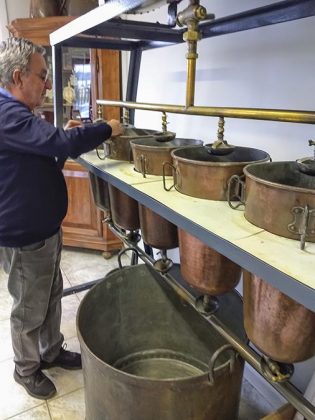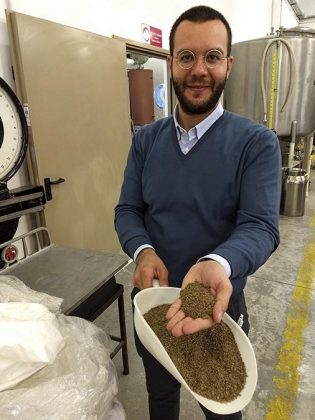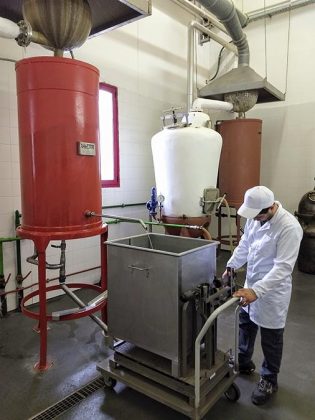As if life ain’t confusing enough, we have this: absinthe, aguardiente, anisette, arrack and arak; and those are just the A’s. Then there’s chinchón, ouzo, pastis, Pernod, raki and sambuca. All are licorice-flavored liqueurs from around the world. I’m sure each has its place and each has its fans. But I’ve always been enamored of anisette, the favored digestif of southern Italians and southern Italian Americans. Or as the Italians spell and pronounce the cordial, anisetta (ahn nee ZET uh).
That’s where this story begins, for me. As a boy growing up in Brooklyn, I had a Sicilian-American uncle who taught me to pour a bit of anisette into our after-dinner demitasse. Always curious about what the hell anisette was, about a half-century later I set out for Ascoli Piceno near the Adriatic in the east-central region of Le Marche, Italy.
Le Marche is where, in its clay soils, cooled and salted by the nearby ocean, grow some of the world’s best anise plants. Dried anise seeds are the base flavoring agent and source material for anisette. And in the outskirts of Ascoli — about 20 kilometers from the sea — is the Silvio Meletti Distillery, which since 1870 has been making clear anisette.
Inside a white, low-slung building sits what appear to be old red-, white- and burnt sienna-painted pot stills which have been churning out three different variations of anisette for a long while.
Meletti produces annually about 200,000 bottles of anisetta — the Classic (34% ABV), Dry (42%) and a Riserva (42%), the latter of which Meletti produces only 100 bottles(!) and which is not available in the US. The production of anisetta represents 50% of Meletti’s total output.
Silvio Meletti, 72, (named for the namesake of the distillery) who has just retired, tells me, “We’re a piccolo (small) producer” of anisette, “but we’re the largest producer of anisette in Italy.”
Why anisette in Le Marche?
Mauro Meletti, 34, a fifth-generation master distiller and head of production, exclaims with a chuckle, “This is my house — my kingdom actually!” He claims the green anise grown in Le Marche is higher in essential oils because of the soil in the area and is “two-to-three times more fragrant than from other Mediterranean areas.” Fragrance is all, and the length of flavor on the palate, when it comes to anisette. “Aroma is king,” he asserts. But he explains, as with wine, the aromas, or anetole, are susceptible to climate differentials, and therefore, anisette can vary from year to year. May through August is prime harvesting season in Le Marche, after which the anise seeds are allowed to dry.
There are other anisette producers in Le Marche, as there are in Bordeaux and in the Andalusia region of Spain, and there is even one producer in the US. Mauro Meletti acknowledges them with a shrug, invoking his family’s legacy as well as some current marketing terminology:
You may think of us as a big name, but since our founder [his great-great-grandfather], we haven’t changed anything. We think of ourselves as artisanal and the concept of a craft distillery fits perfectly with the (notion of) artisanal.
At Meletti, they derive alcohol solution from molasses or grain. They use Italian white sugar (zucchero) from beetroot that has been refined in Bologna about three hours away. Mineral water makes a syrup that’s blended with the anise seeds and distilled two times.
Just as with most fermented and distilled spirits, Meletti discards the first and last portions of the distillate that contains the elements of bitterness and keeps only the “hearts” to ensure that the flavors are concentrated and consistent. Once distilled at proof, a second distillation of other spices (Mauro tells me he’d have to kill me before disclosing the formula, but likely coriander is in the recipe). The liqueur is then transferred to 10,000-liter tanks for 4–6 months of aging in stainless steel.
At what is likely the sole US anisette producer — Vitae Spirits in Charlottesville, VA, founder and head distiller Ian Glomski uses a mixture of aniseseed and fennel from Egypt and house-made sugarcane spirit that he says lends an additional layer of sweetness. Vitae, via distillation, infuses the anise and fennel using a pot still. “I prefer the aniseseed rather than star anise because I find it gives a greener, herbal flavor rather than the resinous spiciness of star anise,” says Glomski. Just before bottling, Glomski cold-infuses fresh lemon zest, which he says gives the final product brightness and a tinge of color.
“I have many fond memories of sipping on anisette diluted with a touch of cold water while playing a mellow game of pétanque (boules or bocci) in the warm sun of the French countryside,” Glomski explains. “I aimed to capture this time and place when building the Vitae Spirits anisette.”
Anisette is but a small percentage of Vitae’s production, about 7% or 700 bottles annually, which is up from 230 units in only three years since Vitae began making anisette. Glomski admits though, “Our anisette is a niche product. People love it, but it is not a high-volume alcohol. When used in cocktails, it is usually a minor volume component and when people drink it straight, it is usually a small digestif after a meal.”
So, what do the various anisettes from around the world taste like? Meletti’s dry anisetta ($21 SRP), for instance, has some favorable Good ’n’ Plenty licorice aromas that tend toward fruity. In the mouth it is very viscous, coating the roof of the palate with delicious, pure anise flavor. Then the appealing bite in the end from the alcohol kicks in, leaving residue — something one can chew on.
Perhaps the globe’s most consumed anisette is the one from Bordeaux from Marie Brizzard ($20 SRP/25% ABV). The nose here is more medicinal than the Meletti, but it has even more viscosity, perhaps from additional sugar. Alas, it has less anise flavor and, in the end, is simpler.
The Vitae, with a higher price tag, $39, possesses a lesser anise nose than its counterparts, while alcohol aromas (40%) prevail. There’s a harsh medicinal quality on the palate. The Vitae, it must be said, is perhaps best for mixing into a cocktail, as its owner suggests. This is also less sweet than the others, which is Glomski’s intent: “If you make a cocktail with them, you don’t carry in all this sugar.”
And what of the myriad other licorice-like concoctions?
Absinthe is, of course, the king of anise drinks, and the most expensive; it carries the cachet of once having been forbidden. Absinthe is derived from botanicals, including the flowers and leaves of wormwood, together with green anise, sweet fennel and other medicinal and culinary herbs. It is commonly referred to as the “green fairy.” It’s sometimes mistakenly referred to as a liqueur, but it’s not traditionally bottled with added sugar and is, therefore, classified as a spirit.
Aguardiente is a Portugese (aguardente), Galician (augardente), Catalan (aigurdent) or Basque (pattar) product. Aguardiente is a generic term for beverages that contain between 29% and 60% ABV. The word is a compound of the word “water” (agua in Spanish; aigua in Catalan; água in Portuguese; auga in Galician) and “burning” or “fiery,” similar to the English firewater. Fruit-based aguardientes include those made from oranges, grapes, bananas or medronho (“cane apple”). Grain-based varieties may be made from millet, barley or rice and tuber-based aguardientes from beet, manioc or potato, and finally what are classed as “true” aguardientes from sugarcane and other sweet canes, including some species of bamboo.
Arrack (from Turkey, Israel), arak (Lebanon), and raki (Albania, Greece, Balkans) are anise spirits of similar makeup and ritual and exist throughout the Mediterranean and Middle East. Turkey’s is made with twice-distilled grapes and aniseseed and is a go-to spirit for celebration or serious discussions. A more potent option is Lebanon’s arak, also seen as “arrack” throughout the Middle East. It’s either herbal, grassy and peppery, or fruitier with a hint of grappa. Raki is often served with seafood or meze.
Chinchón (Spain) is produced in Chinchón near Madrid. The distillate is made using Matalahuga green anise sourced from Seville and uses a 17th-century production method. The drink is made by macerating the anise plant in wine, then distilling the solution in copper stills. Geographic Denomination of Chinchón was recognized in 1989.
Ouzo (Greece, Cyprus) is a clear spirit that is about 40% ABV. It’s made by distilling grape-based tsipoura, similar to Italy’s grappa, and is flavored with anise, fennel, coriander, clove, cinnamon and star anise. When mixed with water or ice, it turns cloudy and white — called the louche effect. In 2006, ouzo received Protected Designation of Origin from the EU, meaning it can only be ouzo if it’s made in Greece, where it’s been produced since 1856.
Pastis (Marseille, France) is referred to as an absinthe alternative and is distilled with star anise, fennel, licorice root and other aromatic herbs, then sugar. It’s lighter than absinthe and often consumed “louched” over ice.
Pernod is a trademarked brand from France, and is the world’s leading licorice-like drink. In its heyday, the Pernod Fils distillery was producing as much as 30,000 liters of absinthe per day. It’s produced by macerating herbs, including wormwood, fennel, melissa and anise in a neutral spirit, usually from fruit, in a copper alembic where the mixture is then distilled. Part of the distillate is then steeped with additional herbs, such as hyssop and petite wormwood, to produce a green-colored fraction that is then filtered and reunited with the main component. The coloration process is done primarily to impart additional flavor and aroma, but the ensuing light olive tint also has the added benefit of enhancing its visual appeal. The distillate is then reduced in strength, with the 68% ABV product representing the most popular version.
Finally, Sambuca is an Italian specialty and is often served with coffee beans — three, to be exact — a preparation known as “con la mosca,” or “with the fly.” Its recipe is guarded, but is said to include star anise oils from China and sugar and wheat for grain spirit sourced throughout Europe. Sambuca reportedly gets its name from the Latin word sambucus, meaning “elderberry,” and has no relation to the Italian town of the same name. It is bottled at a minimum of 38% alcohol. The oils are added to pure alcohol, a concentrated solution of sugar and other flavoring.











